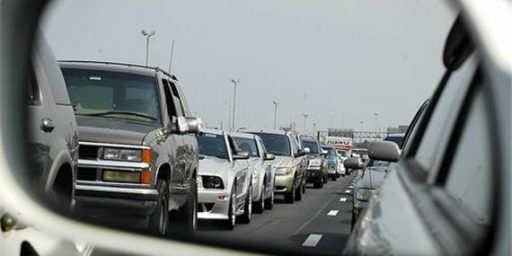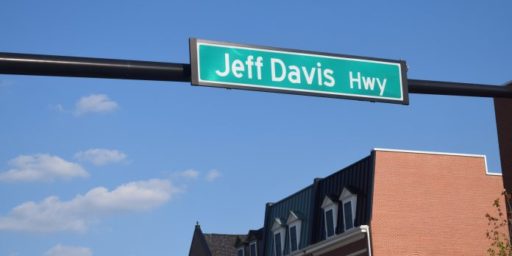HOV Lanes
Virgil Soule has an op-ed in WaPo entitled, “HOV: Never Worked, Won’t Work. Can’t We Get Rid of It?” It expresses a view I’ve had since moving to the DC area that has only been reinforced with my daily commute inside the Beltway.
On a recent Friday afternoon, my wife and I were driving south from the Beltway on Interstate 95 in a long stream of slow traffic. The traffic was understandable: Everyone wanted to be somewhere else for the weekend. What was not understandable were the nearly empty high occupancy vehicle (HOV) lanes running parallel to the four clogged lanes. The lighted sign at the entrance to the open lanes said HOV-3. It soon became apparent, however, that about the only motorists in the HOV lanes were HOV-2 cheaters and single drivers plus the occasional tractor-trailer. Without the HOV restriction, traffic might have been running freely on six lanes instead of crawling along on four.
HOV lanes were established to lure single drivers into carpools to reduce traffic congestion. In the bargain, it was hoped that the concept would reduce exhaust pollution. In principle HOV ought to work, but in reality it hasn’t. HOV has been in use for about 20 years, and commuters still have not rushed to fill the empty space, despite rising fuel prices. From my observation, most vehicles in HOV lanes have one occupant, especially during the high-demand rush hours.
The HOV restriction is more destructive than productive. On I-95 south of the Beltway, the segregated HOV lanes are so underutilized during rush hours that they might as well not exist, and the remaining lane space is inadequate to meet the demand. In the afternoon, traffic on the Beltway’s inner loop upstream of the Interstate 270 exit backs up for miles. The backup occurs because HOV takes away a lane on I-270 and bottlenecks traffic into the remaining lanes. The disruption caused by HOV propagates across all six lanes of the inner loop and continues far upstream.
The function of a highway is to move traffic. The underused HOV lanes degrade the performance of the highway. Abolishing the HOV restriction would provide lane space to allow the highways to run more freely. The highways would be more egalitarian, and everyone would get home sooner.
Some HOV proponents see the traffic congestion endured by single commuters as just punishment for not joining carpools or using public transportation. But this is not the way to solve the nation’s transportation problems.
Indeed not. The only experience I had with HOV lanes prior to moving to Northern Virginia two years ago was while visiting friends in Nashville. Indeed, the idea that the taxpayers would be charged for a road that they couldn’t drive is beyond conception in most of the country.
As Soule says, there is some logic to creating an incentive for people to carpool. In reality, however, it’s a foolish concept. The only places where there is any impetus for HOV lanes is in the major urban centers, where traffic is most congested. Unfortunately, those are precisely the places where they can’t work. Insanely high housing prices force people to live several miles from work. It is not at all uncommon for people who work together to live ninety minutes away from one another. The likelihood of many people from the same office living in the same community is rather small. And, for most white collar jobs, work hours can be rather erratic, so being able to count on the ability to coordinate schedules is doubtful even then.
Structuring one’s life around carpool partners is an unreasonable burden. We live in a society that has been built around the automobile. To do much of anything, one must drive. In a place with this much traffic congestion, people tend to compensate by combining trips to minimize their drive time. When I lived in south Alabama, I thought nothing of running to Wal-Mart or the hardware store if I needed an item or two. Now, I try to run errands around traffic, meaning I either do them late in the evening, early on weekend mornings, or on the way home from work. Not only does that keep me out of traffic but the cumulative pattern of people making that calculation reduces traffic congestion.






Hey, I like HOV lanes. Since the vast majority of occasions I have to go near Atlanta involve my wife and me traveling together, we get to use the HOV lanes, and it makes the drive a whole lot less stressful than trying to use the regular lanes.
Of course, when one of us needs to travel through that area alone it sucks just a little, but still…
I live in southern california. The freeways around here that have HOV lanes generally have a single HOV-2 lane next to 4+ ordinary lane. The HOV lane is almost always busy, but less busy than the regular lanes (and thus, always moving at some reasonable speed).
I like these lanes since making them regular lanes would not significantly decongest the other lanes, but as things are now they allow the cars with the most passengers to avoid being stuck in traffic.
What you say is quite correct – I live 35 miles from my office and I’m the only one in my office who lives out where I live. There’s one woman in Leesburg, but carpooling isn’t really feasible because I tend to work longer hours than she does. Public transportation is cost prohibitive and actually would make my total commute time longer, nevermind the hassle of getting to the nearest Metro station (easily 40-45 mimutes driving), changing from the orange line to the blue/yellow line, then walking for about 20 minutes from the station to my office building. Besides, I get free parking in a garage for my car.
I don’t think the problem is the HOV lane per se. It’s that it’s HOV-3. Make it 2 and it’ll get more use (of course, a lot of that use would be parents with a single child in the car, which doesn’t actually do anything to remove a driver from the road, but it does at least get them out of the main lanes). The HOV lanes in LA are all 2s and, as the commenter above noted, get consistent use. A 3-person restriction, OTOH, is almost seems designed to ensure hardly anyone can use it (Robert Conquest’s Third Law of Politics in action).
Better yet, allow solo drivers to pay a fee to use it – which many would happily do – and it would actually have a chance to live up to its potential.
Unfortunately, every time someone suggests something like the latter, the predictable howls emanate from the liberals about the “rich” getting to have it easier than everyone else, so nothing happens, causing the highest of all liberal policy results: Everyone gets to be equally miserable.
Dodd, they happen to be evaluating HOT (High Occupancy/Toll) lanes for part of the Capital Beltway in Virginia. Not too many screams so far, but they’re also not close to building it.